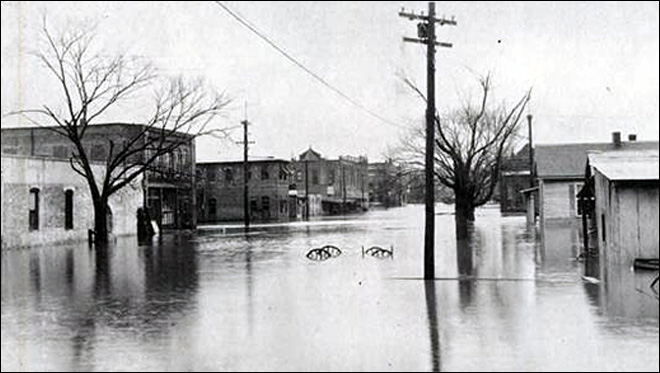
On this page you learn what types of flooding are typical in Georgia and how do you protect yourself, your family and your home. You will also find out more about significant Georgia floods. Finally, you'll find links to NWS offices that provide forecast and safety information for Georgia, as well as links to our partners who play a significant role in keeping you safe.
Learn More:
An extreme flash flood killed 13 people in Whitestone when a general store near the Talona Creek was washed off its foundation. Two children from the Fonder family were staying with the Conner family at the store, which was also their home. It was the first night the Fonder children had spent the night away from home. This event inspired the following poem from a Pickens County resident:
The Whitestone Flood, By Danny Attaway
“May the recent rains and falling timber
Make us all reflect, look back and remember
Upon a fearful night back in 38
When the Conner family met their fate
Mother Father Sons and Daughters
Were all swept away by the swirling waters
The parents of two with the Conners that night
Awoke to the rain and a terrible sight
The creek between them rose beyond belief
As they stood there helpless and took on their grief
Their attempts to rescue were all in vain
As the Conner house crumbled in the pouring rain
At daylight they stood in the wake of the flood
Everyone searched through the rubble and mud
For the 13 souls could not be ignored
As they were ushered in the presence of our almighty Lord
The waters rose in the night as they slept
13 people perished, and all of town wept”
Rainfall amounts of 6-12 inches occurred over northwest Georgia in a 3-day period. This caused record flooding on the Oostanaula and Etowah Rivers that merge to form the Coosa River. Flood waters up to 11 feet deep covered portions of Broad Street in Rome with extensive record flooding. The stage height reached 40.3 feet. Flood stage is 25 feet. This record flood and another major flood in 1892 prompted the citizens of Rome to raise the town by 12 feet. This was accomplished by bringing in thousands of wagon loads of dirt. The current basement level of historic buildings were once at ground level. Also an extensive levee system was constructed in the 1920s on the right banks of the Oostanaula and Coosa Rivers to protect the section of Rome where the people lived at the time.
Learn More:
The event brought rainfall amounts of 6 to 12 inches over a 3-day period primarily oriented over the Chattahoochee River basin from Columbus to Norcross caused extensive flooding up to 3 miles from the river channel. It is notable the flood crests established with this major flood remain as the highest or second highest flood crests on record from Norcross through Atlanta, Whitesburg and West Point to Columbus. In general, flooding around 15 feet above the respective flood stages occurred along the Chattahoochee River. The exception was Columbus where the crest was around 18 feet above flood stage. This also caused the tributary creeks to have record flooding such as Peachtree Creek.
C. F. von Herrmann, Meteorologist, at the Atlanta station of the Weather Bureau wrote a very detailed description of the flood in the following web link:
Learn More:
A break or failure can occur with little to no warning. Most often they are caused by water overtopping the structure, excessive seepage through the surrounding ground, or a structural failure. More information...
| Protect Life and Property NWS Forecast Offices and River Forecast Centers (RFC) Covering Georgia | ||